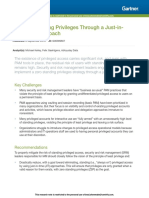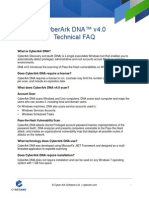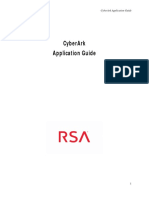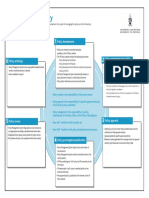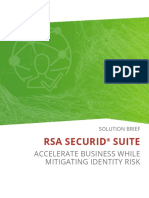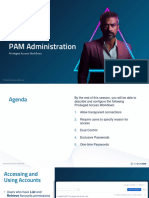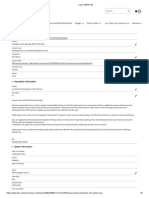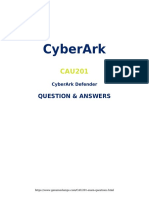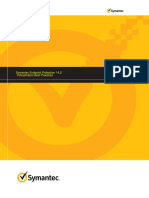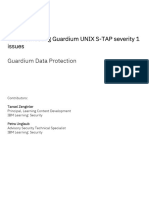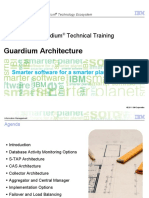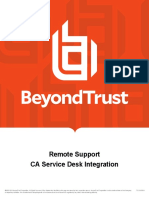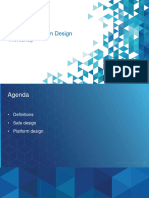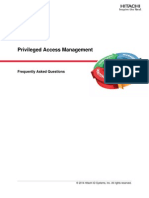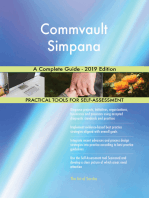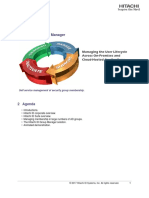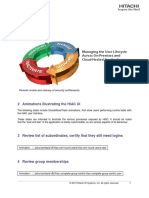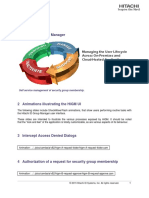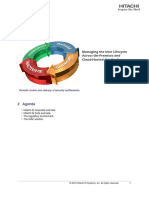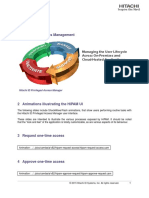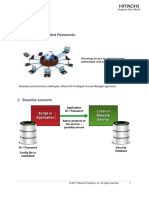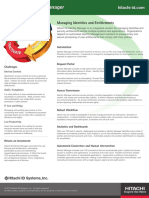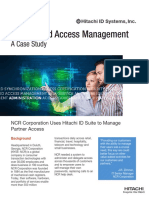0 ratings0% found this document useful (0 votes)
79 viewsPrivileged Access Management Best Practices
Privileged Access Management Best Practices
Uploaded by
HitachiIDThis document describes the business problems which privileged access management systems are in-tended to address. It goes on to describe best practices for defining and enforcing policies regardingdiscovering systems on which to secure access to sensitive accounts, updating and storing privileged pass-words and enabling access to privileged accounts.
Privileged accounts include administrator accounts, embedded accounts used by one system to connect toanother and accounts used to run service programs.
Hitachi ID Privileged Access Manager is a security product that enables organizations to define and enforcepolicies regarding access to privileged accounts on a variety of systems. It enables organizations to control what users and programs have access to what privileged accounts, to control when such access is allowedand how access is activated and deactivated.
Access rights may be permanent or temporary. All access islogged and subject to audit reports.The bulk of this document is general in nature – applying equally to any privileged access managementsystem. A few sections are specific to Privileged Access Manager and are identified as such
Copyright:
Attribution Non-Commercial (BY-NC)
Available Formats
Download as PDF, TXT or read online from Scribd
Privileged Access Management Best Practices
Privileged Access Management Best Practices
Uploaded by
HitachiID0 ratings0% found this document useful (0 votes)
79 views39 pagesThis document describes the business problems which privileged access management systems are in-tended to address. It goes on to describe best practices for defining and enforcing policies regardingdiscovering systems on which to secure access to sensitive accounts, updating and storing privileged pass-words and enabling access to privileged accounts.
Privileged accounts include administrator accounts, embedded accounts used by one system to connect toanother and accounts used to run service programs.
Hitachi ID Privileged Access Manager is a security product that enables organizations to define and enforcepolicies regarding access to privileged accounts on a variety of systems. It enables organizations to control what users and programs have access to what privileged accounts, to control when such access is allowedand how access is activated and deactivated.
Access rights may be permanent or temporary. All access islogged and subject to audit reports.The bulk of this document is general in nature – applying equally to any privileged access managementsystem. A few sections are specific to Privileged Access Manager and are identified as such
Copyright
© Attribution Non-Commercial (BY-NC)
Available Formats
PDF, TXT or read online from Scribd
Share this document
Did you find this document useful?
Is this content inappropriate?
This document describes the business problems which privileged access management systems are in-tended to address. It goes on to describe best practices for defining and enforcing policies regardingdiscovering systems on which to secure access to sensitive accounts, updating and storing privileged pass-words and enabling access to privileged accounts.
Privileged accounts include administrator accounts, embedded accounts used by one system to connect toanother and accounts used to run service programs.
Hitachi ID Privileged Access Manager is a security product that enables organizations to define and enforcepolicies regarding access to privileged accounts on a variety of systems. It enables organizations to control what users and programs have access to what privileged accounts, to control when such access is allowedand how access is activated and deactivated.
Access rights may be permanent or temporary. All access islogged and subject to audit reports.The bulk of this document is general in nature – applying equally to any privileged access managementsystem. A few sections are specific to Privileged Access Manager and are identified as such
Copyright:
Attribution Non-Commercial (BY-NC)
Available Formats
Download as PDF, TXT or read online from Scribd
Download as pdf or txt
0 ratings0% found this document useful (0 votes)
79 views39 pagesPrivileged Access Management Best Practices
Privileged Access Management Best Practices
Uploaded by
HitachiIDThis document describes the business problems which privileged access management systems are in-tended to address. It goes on to describe best practices for defining and enforcing policies regardingdiscovering systems on which to secure access to sensitive accounts, updating and storing privileged pass-words and enabling access to privileged accounts.
Privileged accounts include administrator accounts, embedded accounts used by one system to connect toanother and accounts used to run service programs.
Hitachi ID Privileged Access Manager is a security product that enables organizations to define and enforcepolicies regarding access to privileged accounts on a variety of systems. It enables organizations to control what users and programs have access to what privileged accounts, to control when such access is allowedand how access is activated and deactivated.
Access rights may be permanent or temporary. All access islogged and subject to audit reports.The bulk of this document is general in nature – applying equally to any privileged access managementsystem. A few sections are specific to Privileged Access Manager and are identified as such
Copyright:
Attribution Non-Commercial (BY-NC)
Available Formats
Download as PDF, TXT or read online from Scribd
Download as pdf or txt
You are on page 1of 39
Best Practices for
Securing Privileged Accounts
2014 Hitachi ID Systems, Inc. All rights reserved.
Contents
1 Introduction 1
2 Risk management 2
2.1 Baseline risks . . . . . . . . . . . . . . . . . . . . . . . . . . . . . . . . . . . . . . . . . . . . 2
2.2 Securing privileged accounts . . . . . . . . . . . . . . . . . . . . . . . . . . . . . . . . . . . 3
2.3 New risks once automation manages access to privileged accounts . . . . . . . . . . . . . . 4
2.4 Protecting the privileged access management system . . . . . . . . . . . . . . . . . . . . . 4
3 Server infrastructure 6
3.1 Server numbers and placement . . . . . . . . . . . . . . . . . . . . . . . . . . . . . . . . . . 6
3.2 Database type and placement . . . . . . . . . . . . . . . . . . . . . . . . . . . . . . . . . . . 7
3.3 Use of rewalls . . . . . . . . . . . . . . . . . . . . . . . . . . . . . . . . . . . . . . . . . . . 8
3.4 Virtual vs. physical servers . . . . . . . . . . . . . . . . . . . . . . . . . . . . . . . . . . . . . 10
3.5 Impact on network and storage randomizing passwords . . . . . . . . . . . . . . . . . . . 10
3.6 Impact on network and storage session recording . . . . . . . . . . . . . . . . . . . . . . . 11
3.7 Server sizing . . . . . . . . . . . . . . . . . . . . . . . . . . . . . . . . . . . . . . . . . . . . 12
3.8 Load balancing and replication . . . . . . . . . . . . . . . . . . . . . . . . . . . . . . . . . . 12
4 When and how to randomize privileged passwords 15
5 Securing access disclosure 16
5.1 Identication, authentication and authorization . . . . . . . . . . . . . . . . . . . . . . . . . . 16
5.2 Access disclosure mechanisms . . . . . . . . . . . . . . . . . . . . . . . . . . . . . . . . . . 18
5.3 Concurrent disclosure (checkin/checkout) . . . . . . . . . . . . . . . . . . . . . . . . . . . . 19
6 Recording login sessions 21
7 Reporting on access disclosure 22
8 System monitoring and maintenance 23
8.1 Allocating staff to monitor and maintain the system . . . . . . . . . . . . . . . . . . . . . . . 23
8.2 Monitoring system health . . . . . . . . . . . . . . . . . . . . . . . . . . . . . . . . . . . . . . 24
9 Conguring target system integrations 26
i
Best Practices for Securing Privileged Accounts
10 Production migration 28
11 API Considerations 29
12 Summary 32
APPENDICES 33
A Hitachi ID Privileged Access Manager Overview 34
2014 Hitachi ID Systems, Inc. All rights reserved.
Best Practices for Securing Privileged Accounts
1 Introduction
This document describes the business problems which privileged access management systems are in-
tended to address. It goes on to describe best practices for dening and enforcing policies regarding
discovering systems on which to secure access to sensitive accounts, updating and storing privileged pass-
words and enabling access to privileged accounts.
Privileged accounts include administrator accounts, embedded accounts used by one system to connect to
another and accounts used to run service programs.
Hitachi ID Privileged Access Manager is a security product that enables organizations to dene and enforce
policies regarding access to privileged accounts on a variety of systems. It enables organizations to control
what users and programs have access to what privileged accounts, to control when such access is allowed
and how access is activated and deactivated. Access rights may be permanent or temporary. All access is
logged and subject to audit reports.
The bulk of this document is general in nature applying equally to any privileged access management
system. A few sections are specic to Privileged Access Manager and are identied as such.
Look for the marks throughout this document to nd best practices.
2014 Hitachi ID Systems, Inc.. All rights reserved. 1
Best Practices for Securing Privileged Accounts
2 Risk management
2.1 Baseline risks
Organizations face signicant security exposure in the course of routine IT operations. For example, dozens
of system administrators may share passwords for privileged accounts on thousands of devices. When
systemadministrators move on, the passwords they used during their work often remain unchanged, leaving
organizations vulnerable to attack by former employees and contractors.
Other security problems related to administrator accounts include:
When many people need to know a single password, it is difcult to coordinate changes to the pass-
word in a manner which does not - at least temporarily - make the password unavailable to some of
the people who need it.
Lockout of an administrator account can be catastrophic. Consequently, administrator passwords
are frequently not subject to a policy requiring regular updates or intruder lockouts. This can make
administrator passwords less secure than user passwords.
When multiple administrators share access to a single privileged account, it is impossible to associate
administrative changes with the people who initiated them. This lack of accountability may violate
internal control requirements.
Some organizations manage the most secure passwords by periodically changing them, writing them down
and literally storing them in a safe. This approach sounds secure but it creates its own set of business risks:
If an administrator is called upon to repair a system outside of normal ofce hours, he has no easy
access to the privileged password. This may signicantly impair the administrators ability to quickly
and effectively x the system in question.
A physical disaster at one site, such as an earthquake, hurricane, re or ood may make a privileged
password database unavailable at other sites, amplifying the scale of damage.
In addition to privileged accounts used by IT system administrators, there are also privileged accounts used
by one application to connect to another. For example, many web applications use a login ID and password
to connect to databases, directories or web services. These accounts may have their own security risks:
Embedded passwords are often stored in unencrypted text les. This means that an intruder who
compromises the security of the operating system where an application is installed will also compro-
mise the integrity of the network services which the application routinely connects to.
Applications are often replicated across multiple servers, to provide higher throughput and fault toler-
ance. This means that multiple application servers may house their own copies of the same plaintext
login IDs and passwords. This makes it very difcult to change passwords, since every change must
be coordinated between a back-end system and multiple instances of a front-end system.
2014 Hitachi ID Systems, Inc.. All rights reserved. 2
Best Practices for Securing Privileged Accounts
Finally, unattended processes on Windows systems also run with a login ID and password. This includes
service accounts, scheduled tasks, anonymous access to web content and more. Many applications only
work when these services have elevated privileges. This also creates business risk:
Where the service account is a local account on the system where a service executes, any change
to the service password must be coordinated with every service which uses the account. This is
difcult, in part because of the variety of Windows components which may be affected service
control manager, Windows scheduler, IIS and third party software.
Where a service program runs on a domain controller or runs using Active Directory credentials, a
change to a single password in AD may trigger a need to notify many Windows components, on many
computers that participate in the AD domain of the new password.
In each of the above cases, the risks can be summarized as:
Weak password management means that the most sensitive passwords are often the least well de-
fended.
The need to coordinate password updates among multiple people and programs makes changing the
most sensitive, privileged passwords technically difcult.
Inability to secure sensitive passwords exposes organizations to a variety of security exploits.
Strong, manual controls over access to privileged accounts may sometimes create unanticipated
risks, such as impaired service in IT operations and escalation of physical disasters from one site to
an entire organization.
Inability to associate administrative actions with the people who initiated them may violate internal
control requirements.
2.2 Securing privileged accounts
A privileged access management system works to mitigate the baseline risks identied in the previous
section:
The passwords associated with privileged accounts are periodically randomized. This means that
they cannot be shared or stored in plaintext les.
A combination of persistent access control rules and one-time workow request processes support
disclosure of access to privileged accounts.
IT staff are personally authenticated prior to requesting, approving or gaining access to a privileged
account. This ensures accountability for changes they may make using that account.
Access disclosure can take a variety of forms. It does not necessarily (or normally) mean that pass-
words are displayed to users.
Password changes are coordinated between back-end systems and the programs (front-end systems)
that need to use them.
2014 Hitachi ID Systems, Inc.. All rights reserved. 3
Best Practices for Securing Privileged Accounts
Login sessions to privileged accounts are recorded, at least at the level of meta data who connected
to which account on which system at what time from what device and in some cases in detail
screen capture, key logging, etc.
2.3 New risks once automation manages access to privileged accounts
Once a privileged access management system is deployed, baseline risks are addressed but new risks
must be considered:
Disclosure of privileged passwords would be catastrophic, as it would enable an intruder to imperson-
ate any privileged user.
Damage to the credential vault or loss of access to this database would create an operational disaster
across the entire organization, since administrators would be locked out of every system.
2.4 Protecting the privileged access management system
The privileged access management systems credential vault must be protected against disclosure:
The system itself must be installed on a secure platform for example, with a minimal set of
services running, in a physically secure facility, with a minimal number of people able to gain
administrative access to the console, etc.
All sensitive data, and in particular all stored passwords, must be encrypted.
Encryption keys must themselves be protected in a manner that is difcult to defeat.
Authorization policies must identify the users who can sign into the system at all and control
which users can gain access to what privileged accounts.
Workow rules must control unusual requests for access, to ensure that all such requests are
authenticated, validated and authorized before access is granted.
The privileged access management system as a whole must be designed to ensure high availability:
There can be no single point of failure:
*
The systems credential vault must be replicated between at least two servers.
*
Multiple privileged access management servers must be deployed at physically distinct sites,
so that a physical disaster at one location does not escalate into a situation where access to
privileged accounts is impossible from other locations.
In the event that a single instance of the password management system or credential vault is
off-line, other instances should continue to be able to, at least, disclose access to authorized
users.
*
Password changes should be suspended at other locations if new password values cannot
be replicated, since storing new password values at just a single site would create a (new)
single point of failure.
2014 Hitachi ID Systems, Inc.. All rights reserved. 4
Best Practices for Securing Privileged Accounts
The password change process should be protected against race conditions.
Failure to update a password on a target system should not result in the new password being
stored in the credential vault.
In (rare) cases where it is impossible to determine whether a password update succeeded or
failed, both the old and new password should be stored in the credential vault.
The password change process should support recovery of managed systems from backup media.
Very old password should remain accessible in a history table, in the event that they are needed
to activate a backup copy of a system.
2014 Hitachi ID Systems, Inc.. All rights reserved. 5
Best Practices for Securing Privileged Accounts
3 Server infrastructure
This section describes how a privileged access management system should be congured, to support the
business objectives of high scalability and high availability.
3.1 Server numbers and placement
Fundamentally, a privileged access management system should always be deployed with at least two
servers, preferably located in two different physical sites. This arrangement prevents system failure due
to component failure:
Hardware failure on a single server.
Network connectivity lost between users and a single server.
A complete site is knocked ofine due to a physical, network or power outage.
Multiple servers should carry on near-real-time data replication. As the number of servers grows, so too
will the volume of replication trafc between them. Since servers should be at different physical sites, the
database replication trafc will be carried over a wide area network. The net result of all this is that while
having at least two servers is essential, having too many servers will signicant reduce overall system
performance. Consequently, it is recommended that organizations deploy no more than three replicated
privileged access management servers.
The next question is where the servers should be placed on the network. While it is impossible to answer
this question in the general sense no two network topologies are alike it is possible to offer some general
guidance:
Connectivity between multiple, replicated servers should be fast, to minimize the performance penalty
due to replication.
This means that password management servers should be placed in sites with excellent wide
area network bandwidth.
Connectivity between password management servers and devices on which they manage passwords
should be fast, since the native password update protocols of some systems do not perform well if
bandwidth is low or latency is high.
This means that password management servers should be installed in major data centers, along-
side as many managed systems as possible.
Connectivity between end users and the password management servers is typically over HTTPS,
which is designed to tolerate low bandwidth and high network latency.
This means that password management servers do not have to be co-located with users it is
more important to place them near target systems.
2014 Hitachi ID Systems, Inc.. All rights reserved. 6
Best Practices for Securing Privileged Accounts
3.2 Database type and placement
Whereas the preceding guidance applies to any privileged access management system, the following guid-
ance is specic to Hitachi ID Privileged Access Manager:
Privileged Access Manager supports two types of databases:
Microsoft SQL Server (2005, 2008) and Oracle (10g, 11g).
Standard, enterprise and free, express editions of these database servers are technically
supported, but express editions should only be used in proof of concept or demonstration sys-
tems.
The choice of database Microsoft or Oracle should be based on organizational norms.
Organizations that typically deploy SQL Server on Windows servers should use SQL Server,
while organizations that prefer Oracle databases for mission-critical applications should use that
database.
Organizations may opt to:
Install the database server software on the same server as the Privileged Access Manager ap-
plication itself (shown in Figure 2 on Page 8); or
Install the database server software on a dedicated server, physically and logically near each
Privileged Access Manager application server (shown in Figure 1 on Page 7); or
Leverage an existing, replicated, enterprise-scale database server and congure each Privileged
Access Manager server to connect to this existing infrastructure (shown in Figure 3 on Page 8).
Figure 1: Two PAM servers, each also hosting its own database
While any of the above three congurations will technically work, Hitachi ID Systems recommends the
rst option:
Conguring each Privileged Access Manager server with its own, physically distinct database
instance increases reliability by eliminating single points of failure (i.e., the enterprise database
infrastructure and/or connectivity to that infrastructure would constitute a single point of failure).
2014 Hitachi ID Systems, Inc.. All rights reserved. 7
Best Practices for Securing Privileged Accounts
Figure 2: Two PAM servers plus two database servers
Figure 3: Two PAM servers, connected to a shared database infrastructure
Where physical (rather than virtual) servers are used to host Privileged Access Manager, shar-
ing hardware between the Privileged Access Manager application and the database reduces
hardware cost, while only minimally impacting performance.
If an organization chooses to deploy the Privileged Access Manager database on separate server
from the Privileged Access Manager application, the two should at least be on the same network
segment.
This reduces communication delays between the application and database and consequently
improves runtime performance.
3.3 Use of rewalls
A privileged access management system contains and controls disclosure of very sensitive information.
This naturally raises the question of whether and how rewalls could be leveraged to increase the security
of the system itself.
It is reasonable to place rewalls between end users and the privileged access management system. As-
suming that the user interface runs on HTTPS on port TCP/IP 443, it is straightforward to limit inbound
connections from users to just port 443.
Moreover, an application-level rewall (congured as a reverse web proxy) could:
2014 Hitachi ID Systems, Inc.. All rights reserved. 8
Best Practices for Securing Privileged Accounts
Optionally, terminate SSL connections from users.
Check incoming trafc and block unreasonable HTML form payloads, cookies, etc.
A rewall between a privileged access management system and devices on which passwords are being
managed can also be used. Since every type of target systemmay use a different protocol, the conguration
of a rewall in this location could allow any connection initiated by the privileged access management
system but block any connection initiated in the other direction.
Finally, a rewall may be considered between the privileged access management system and its internal
database. This is actually not recommended:
There is little or no security benet, since the privileged access management system will need largely
unlimited access to the database to store and retrieve passwords, change conguration settings,
etc.
There is a possibility of introducing performance and reliability problems. For example, a rewall
might (mistakenly) terminate an inactive database connection. A subsequent burst of activity on the
privileged access management system would have to handle this error condition. This sort of problem
can be quite difcult to diagnose.
An optimal rewall conguration to protect multiple PAM servers is illustrated in Figure 4.
Figure 4: Protecting PAM servers with rewalls
2014 Hitachi ID Systems, Inc.. All rights reserved. 9
Best Practices for Securing Privileged Accounts
3.4 Virtual vs. physical servers
The following guidance is specic to Hitachi ID Privileged Access Manager:
Privileged Access Manager is tested on and supports running on virtual machines, such as VMWare
ESX servers.
Virtual servers typically (but not in every conguration) exhibit 2x to 3x slower I/O performance as
compared to physical servers.
Placing the Privileged Access Manager application on a virtual server is therefore acceptable, subject
to the ability of the virtual infrastructure to handle the required workload of running a database, auto-
discovery, password changes and access disclosure requests.
Whether the database server (Microsoft SQL Server or Oracle Database) will exhibit adequate per-
formance on the virtual server is also an important consideration, but this is a topic best addressed
by Microsoft or Oracle, rather than Hitachi ID Systems. Hitachi ID Systemss only comment is that it
works when we test it, but performs less well than hardware.
Putting the above into practical perspective, a system where 5,000 passwords are randomized daily
can reasonably be congured to run with Privileged Access Manager and SQL Server on two repli-
cated dual-core virtual servers.
3.5 Impact on network and storage randomizing passwords
Whenever Hitachi ID Privileged Access Manager randomizes a password, the resulting database records
(current password value, password history, log events, etc.) consume 5.1 kbytes each on Microsoft SQL
Server and 3.1 kbytes each on Oracle Database.
Using the round number of 6 kbytes/password change, this means that an organization wishing to secure
5,000 privileged accounts; change passwords daily and retain archival password data for 3 years will require
a database with:
6 kbytes x 5000 passwords/day x 365 days/year x 3 years
= 32,850,000 kbytes of database disk space
= 32,850 Mbytes of disk space
= 33 Gbytes of disk space
Assuming some overhead for workow requests, system conguration, etc. (i.e., double the space require-
ment to be safe), it is reasonable to congure the above system with about 60 Gbytes of disk, regardless of
which database type is used.
It should be noted that the Express Editions of Microsoft SQL Server and Oracle Database are both limited
to 2 GByte databases, which underscores the need to deploy with a standard or enterprise edition of either
database in a production deployment, rather than the Express Edition (which is only suitable for test, QA,
etc.).
2014 Hitachi ID Systems, Inc.. All rights reserved. 10
Best Practices for Securing Privileged Accounts
Similarly, the amount of trafc that Privileged Access Manager transmits between servers to replicate the
storage of changed passwords is just under 1 kByte/password. Using the same example organization, we
can estimate about 5 MByte/day of replication trafc associated with password updates - though probably
more than that will be needed to replicate workow requests, login audit records, access disclosure, etc.
adding up to about 100 MByte/day total replication trafc.
The above bandwidth is strictly to handle replication between servers. Additional bandwidth is consumed
between Privileged Access Manager and target systems (to randomize passwords) and between end users
and Privileged Access Manager (to request and acquire privileged access):
To reset a single password on AD or Unix: about 10 kbytes.
To list all users in AD, so they can sign into the privileged access management system: 500 kbytes
for every 1000 users.
To list all computers in AD, so they can be automatically managed: 500 kbytes for every 1000 com-
puters.
To list local service and administrator accounts on a single Windows computer: under 100 kbytes
(assuming just a few accounts are found).
To request access to a privileged account from the privileged access management system web UI:
under 500 kbytes.
Total network impact can be estimated based on the rough metrics above, multiplied by the workload pro-
jected for the system.
3.6 Impact on network and storage session recording
When Hitachi ID Privileged Access Manager is used to record login sessions while users are connected to
privileged accounts, there are essentially two data streams low intensity data such as keyboard events,
copy buffer data, window titles and so on and high intensity data principally consisting of screen captures
and (where enabled) webcam pictures.
Of these, the high intensity data stream is far larger so will be considered exclusively. Typical data streams
are as follows:
1. 10kbytes/sec per monitor per active user session.
2. The data is stored on the lesystem, not the database.
Assuming that 100 sessions will be recorded concurrently for 8 hours/day, 220 days/year with data retained
for 7 years, this amounts to:
1. Network bandwidth per user PC: 100kbits/sec.
2. Total bandwidth to all Privileged Access Manager servers: 10Mbits/sec.
2014 Hitachi ID Systems, Inc.. All rights reserved. 11
Best Practices for Securing Privileged Accounts
3. Network storage across all Privileged Access Manager servers:
(a) 30 Gbytes/day
(b) 6.4 Tbytes/year
(c) 45 Tbytes in archive
3.7 Server sizing
The preceding discussion is helpful when deciding where to place Hitachi ID Privileged Access Manager
servers and databases. This leaves open the question of how to congure the hardware for each server.
Following is a reasonable conguration, which attempts to balance performance with cost given component
costs as of January, 2010:
Quad core CPU.
4GB RAM.
2 600GB 10K RPM serial-attached SCSI disks in a mirrored conguration.
Gigabit NIC.
Redundant power supply.
Windows 2003 standard edition.
A single server congured like this can reasonably change (randomize) at least 100,000 passwords on tar-
get systems every 24 hours while concurrently servicing at least 100 concurrent, interactive user sessions.
In any deployment, at least two such servers should be deployed, with each server housing a complete
database replica and the Privileged Access Manager software. The servers should be installed at different
sites.
A virtual machine conguration should be congured with similar disk, I/O, CPU and memory capacity.
3.8 Load balancing and replication
Given that at least two privileged access management systems are deployed and assuming that both
servers are active at all times, the next question is how to congure load balancing so that users can
access both servers.
Load balancing can be accomplished using a variety of mechanisms, including:
Associating multiple IP addresses (i.e., one per server) with a single DNS name, as illustrated in
Figure 5 on Page 13.
For example, when a user attempts to connect to the URL https://pam.acme.com/ the DNS ad-
dress pam.acme.com may resolve to one of two different IP addresses, chosen at random.
Using a reverse web proxy in the same manner as a load balancing device (i.e., same strategy as
above but using the TCP rather than IP level protocol), as illustrated in Figure 6 on Page 13.
2014 Hitachi ID Systems, Inc.. All rights reserved. 12
Best Practices for Securing Privileged Accounts
Directing all connection attempts to a single IP address, but using a load balancing network device at
that address to forward connections to multiple servers through some load distribution algorithm, as
illustrated in Figure 7 on Page 13.
Figure 5: Load balancing using multiple IPs on a single DNS name
Figure 6: Load balancing with a reverse web proxy
Figure 7: Load balancing by routing to different IP addresses
Each of these techniques will work. DNS may be preferable since it requires no special infrastructure and
depending on the type of DNS server software used may be congurable so that the server IP address
returned from each DNS query is chosen to be the server closest to the requesting user.
This is best illustrated with an example:
Consider an organization with two data centers one in New York and another in London.
Assume that a privileged access management server is deployed to each each data center, with the
following DNS names and IP addresses:
2014 Hitachi ID Systems, Inc.. All rights reserved. 13
Best Practices for Securing Privileged Accounts
pam-nyc.acme.com at 10.10.10.1
pam-lon.acme.com at 10.20.20.1
The DNS server is congured to resolve the DNS names of both servers to the appropriate IP ad-
dresses.
The DNS server is congured to return a PTRrecord to either pam-nyc.acme.com or pam-lon.acme.com
when requests are made for pam.acme.com.
The choice of PTR records to return is optimized based on the IP address of the DNS client (i.e.,
London or NYC).
In the event that either PAM server is ofine, NYC users can still request pam-lon and London
users can still explicitly request pam-nyc.
In the event that an entire site is ofine, the default load balancing algorithm will resolve the
still-accessible, local PAM server.
Regardless of the load balancing technology used, sessions from a given client to a given PAM server
should be sticky in the sense that the same PAM server will be used throughout the session. This is
important as it eliminates the need for multiple PAM servers to replicate session state date, so signicantly
lowers the need for bandwidth.
2014 Hitachi ID Systems, Inc.. All rights reserved. 14
Best Practices for Securing Privileged Accounts
4 When and how to randomize privileged passwords
The entire premise of a privileged access management system is to secure privileged accounts by periodi-
cally scrambling their passwords, so that current password values are not known to users or programs until
and unless they are actually needed and that disclosure is authorized and logged.
This premise raises an obvious question: when should passwords be randomized and how should the
random passwords be composed?
Since both changing passwords and strong, random password values are inexpensive in terms of
disk space and network bandwidth, it seems reasonable to change privileged passwords often for
example, every 24 hours.
A given password should not be changed if either:
It is in use by users or programs.
It is impossible to replicate storage of the new password value to (e.g., network is down, etc.)
since the new password, stored in a single database, would then constitute a single point of
failure.
Passwords should also be changed after each administrator session is nished. For example, if an
administrator checks out a password for an hour and checks in the the same password 30 minutes
later, then the privileged access management system should immediately randomize the password.
This ensures that any subsequent changes made to that system were not made by the administrator
in question reducing the time window for which the administrator is held accountable.
Random passwords should be long and complex enough to be impractical to guess (by a human
being) or crack (by a machine). Passwords should not be arbitrarily long, however they should be
short enough for a human being to be able to quickly write down and type, in cases where actual
password disclosure is required, such as when login is required to the console of a server which is
ofine.
For example, a 16-character random password constructed from lowercase letters, uppercase
letters and digits may have any of 4.76 10
28
combinations in other words, impervious to
guessing attacks.
As it happens, most systems (but not older IBM mainframes, unfortunately) support passwords
in this format.
2014 Hitachi ID Systems, Inc.. All rights reserved. 15
Best Practices for Securing Privileged Accounts
5 Securing access disclosure
5.1 Identication, authentication and authorization
A privileged access management systems job is not only to randomize and store privileged passwords
but also to connect users and programs to privileged accounts. Otherwise, the privileged accounts whose
passwords were randomized would become inaccessible.
Access disclosure must be controlled:
Users and programs which would like to gain access to a privileged account (clients) must rst
identify themselves.
Once identied, clients must authenticate themselves i.e., prove that they really are who they claim
to be.
The privileged access management system must determine which privileged accounts an authenti-
cated client is authorized to access.
The privileged access management system must record all activity identication, authentication,
authorization and access disclosure, to create a trail of accountability.
Following are some best practices for identication, authentication, authorization and audit:
Introducing a new set of user identiers or passwords would just add complexity and is strongly dis-
couraged.
Assuming that organizations which intend to deploy a privileged access management system already
have a corporate user directory, such as Active Directory, it makes sense to leverage unique user
identiers from this directory to identify users of the privileged access management system.
In the case of a single AD domain, the samAccountName or userPrincipalName attributes
can be used.
In the case of multiple AD domains or other directories, a domain-qualied identier such as a
fully qualied e-mail address may be more appropriate.
Once a (human) user has been identied, he must also be authenticated:
The same directory which was used to identify users does not have to be used to also authenti-
cate them, so long as login accounts on different systems can be reliably correlated.
In organizations with a low security threshold, Integrated Windows Authentication (IWA) can be
used, for example using Kerberos tokens. It should be noted that since the user may have
authenticated hours earlier and may have walked away from his workstation, this is only as
secure as the physical security of the users location plus the time duration of inactivity before
the users screen saver is activated.
In organizations with a medium requirement for security, the users Active Directory password
may be re-entered (i.e,. HTML forms based authentication) and validated against Active Directory
2014 Hitachi ID Systems, Inc.. All rights reserved. 16
Best Practices for Securing Privileged Accounts
or another system or application (e.g., LDAP, Lotus Notes, RACF, Oracle database, etc.). This is
fresh authentication so is presumably a bit more secure than IWA.
In organizations with a need for stronger security, a hardware token with a one time password
technology (e.g., RSA SecurID) or a smart card may be used. These two-factor authentication
technologies are less convenient to use, have difcult boundary conditions (e.g., lost or stolen
token or smart card) but are quite difcult to impersonate.
There are two basic strategies for authorizing access disclosure:
Users may be assigned permanent access rights. For example, a set of users may be dened
who are allowed to access local administrator accounts on a set of Windows servers whenever
they need to.
Users may request temporary access rights. For example, a programmer may request access
to a production application server for a four hour interval, to perform a version upgrade or assist
with troubleshooting a production problem.
Permanent access rights are best accomplished using access control lists (ACLs):
Individual users are placed into user groups.
This can be ofoaded to an existing system, such as Active Directory.
Individual managed systems where passwords to privileged accounts are managed are attached to
managed system policies.
This can be automated using expressions based on data such as server name, IP address, OS
type and patchlevel, etc.
Designated groups of users can be assigned specic rights to systems attached to designated poli-
cies.
For example, users whose AD account is a member of IT_WINDOWS_OPS are able to retrieve
passwords for the local Administrator account on servers belonging to the NYC_WINDOWS_SERVERS
policy.
Temporary access rights are best accomplished using a request workow:
A request has at least three participants (one person may take on more than one of these roles):
*
A single requester, who lls in the request to disclose access.
*
A single recipient, who will get temporary access if the request is approved.
*
One or more authorizers, who are chosen based on the identity of the requester, the identity
of the recipient and the managed system(s) identied in the request.
Requests may require entry of supporting information, such as a ticket number, time interval
during which access is required, etc.
Depending on whether the list of available servers is considered to be a secret or public knowl-
edge within an organization, the system may be congured either to allow any user to act as a
requester, or only some users.
2014 Hitachi ID Systems, Inc.. All rights reserved. 17
Best Practices for Securing Privileged Accounts
The choice of authorizers should, in general, be based on the identities of the recipient and the
managed system and privileged account being requested.
It is best to invite more authorizers than are strictly required to approve a request. This means
that if some are busy or unavailable, others may still respond.
*
For example, each managed system policy may have three authorizers assigned, but any
one of them has authority to approve access disclosure.
It is best to invite every relevant authorizer at the same time, rather than waiting for one to approve
before inviting the next. This improves response time and reduces system complexity.
*
For example, if the recipients manager plus one of three system or policy owners must
approve a request, it is best to invite them all at the same time.
It should be assumed that sometimes authorizers will be unavailable (time off, in a meeting, etc.).
The system should cope with these situations:
*
Check authorizers out-of-ofce status on the e-mail system before inviting them to act. If
they are out, invite someone else.
*
Send periodic reminders to non-responsive authorizers.
*
Invite alternate authorizers if authorizers continue to be non-responsive.
It follows that some mechanism is needed to identify alternate authorizers if the original ones are
unresponsive or known to be unavailable.
*
A common technique is to invite an authorizers manager to act if the authorizer is unavail-
able.
*
Another approach is to designate a security teamto which all ignored requests are escalated.
5.2 Access disclosure mechanisms
A privileged access management system is normally congured to control access by people and programs
to privileged accounts. The previous section covered authentication and authorization of users who wish to
gain this access. This still leaves open the question of how disclosure is actually accomplished.
There are several approaches to disclosing access:
Where access to a privileged account is disclosed to a human system administrator:
The simplest approach is to display the current (most recently scrambled) value of the password
for the privileged account.
*
This is appropriate when the privileged account is on a system that is not reachable over
the network, so the administrator will have to physically type the password at the systems
console.
*
When displaying a password, it makes sense to automatically remove it from the administra-
tors screen after a short while, to minimize the risk of shoulder surng.
2014 Hitachi ID Systems, Inc.. All rights reserved. 18
Best Practices for Securing Privileged Accounts
Where there is connectivity to the target system, it makes sense to avoid displaying privileged
passwords entirely:
*
The main method for doing this is to automatically launch a login session (RDP, SSH,
vSphere, SQL Studio, etc.) from the privileged access management systems user inter-
face, so that the administrator never sees the password. This approach offers administrators
a single sign-on process, thereby reducing the burden of having to sign into privileged ac-
counts through the privileged access management system and not directly.
*
Another good mechanism is for the privileged access management system to create a tem-
porary trust relationship between the privileged account and the authorized users regular
account. This can be done by manipulating SSH .ssh/authorized_keys les or Win-
dows group memberships. This approach is advantageous because logs on the managed
system, not only on the privileged access management system, indicate who signed on to
perform administrative actions. It is also advantageous in that it offer single sign-on to Unix
administrators from their Unix workstations (no ActiveX).
*
Another approach, where the above two are not available, is to place a copy of the privileged
password in the administrators copy buffer, so that he can paste it into a login prompt and
not see it at all.
*
In general, the options offered for access disclosure should be policy driven. Most users
should not have an option to display passwords, for example.
Where a service accounts password is changed:
The privileged access management system should update the Service Control Manager, Win-
dows Scheduler, IIS or other Windows component with the new password value, so that the next
time the account in question is used to start a process, the correct password is available.
This mechanism needs to be extensible, since third party programs may also need to be able
to start processes, and starting processes on Windows always requires a login ID and current
password.
Where an embedded application accounts password is changed:
An API should be exposed, allowing the client application to fetch the new password when it next
needs to connect to the server where a password was changed.
Alternately, a process on the privileged access management system should be able to push the
new password to the application, for example by rewriting a conguration le where the password
is stored.
5.3 Concurrent disclosure (checkin/checkout)
Since a privileged access management systemis able to control disclosure of access to privileged accounts,
it is also in a position to control how many people can gain access to the same privileged account at the
same time. This is useful for two reasons:
It helps avoid confusion that may arise when administrators do not coordinate their changes.
2014 Hitachi ID Systems, Inc.. All rights reserved. 19
Best Practices for Securing Privileged Accounts
It improves accountability by limiting the number of people who could have been responsible for a
change made to a system at a given time.
With this in mind, its reasonable to promote some best practices:
On most systems, the limit should be one administrator at a time. This maximizes accountability and
eliminates the possibility of poor coordination causing conguration errors.
On very large systems, where there are constant administrative changes, the limit should be set
higher for example 2 or 3 administrators at a time. In this case, when the second administrator
starts a session, he should be informed of the rst administrators session in the privileged access
management systems user interface, while the earlier administrator should be sent an e-mail or SMS
message to notify him of the new session.
With concurrency controls in place, a risk arises that one administrator will check out access to a privileged
account, leave the session active and stop working (go home, leave for lunch, etc.). If another administrator
needs access to the same system during the time interval when the rst administrators session is still active
but the rst administrator has left, then the system will be inaccessible. To mitigate this risk, it is important
to set time limits on administrative sessions for example, a 1 hour default and a 4 hour maximum. This
reduces the time window during which a system is unmanageable because of an unused but still open
session.
A second consideration that relates to concurrency controls is how to enforce them in the event that a
password was actually displayed to the user who gained access to a privileged account? The administrator
in question will still have the password, even after the password checkout time interval has elapsed. To
reliably end the administrators session, it is important to, if possible:
Randomize the privileged password as soon as possible:
When the administrator pro-actively checks in the privileged access, or
When the permitted time interval has elapsed.
If technically possible (it may not be) and acceptable to the administrators in question, terminate still-
open connections between the administrator and the system in question (e.g., SSH, RDP, etc.).
This may only work if the privileged access management system can itself connect to the system
being managed and remotely (a) enumerate and (b) terminate sessions.
This may not be desirable, since administrators may be working for a longer time than initially
anticipated and terminating their sessions may be disruptive to their work.
2014 Hitachi ID Systems, Inc.. All rights reserved. 20
Best Practices for Securing Privileged Accounts
6 Recording login sessions
Where a privileged access management system is used to sign users into privileged accounts, it can also
be used to record their actions. In principle, session recording could use a variety of techniques packet
snifng, desktop instrumentation, server instrumentation or a proxy connection.
In the interests of supporting as many types of protocols and client/server administrative protocols as pos-
sible, it makes sense to instrument the client rather than the server or an intermediate proxy system. Client
workstations can be monitored using ActiveX technology, so no software need be installed on either user
PCs or servers.
ActiveX instrumentation is only available on Internet Explorer on Windows. Where IT staff need to connect to
systems from other types of endpoint devices, it makes sense to implement Citrix Presentation Manager or
Windows Terminal Server systems, so that users can continue to launch connections from their accustomed
endpoint devices but session recording will still work.
Given that instrumentation is used, it makes sense to do the following:
1. Limit instrumentation to connections to sensitive systems. This will reduce network and storage re-
quirements.
2. Capture video and keyboard data, to create an audit trail of user actions.
3. Reconstruct keystroke data into text, to the extent possible, so that it can be searched.
4. Capture the copy buffer, in the event that a user pastes rather than types commands.
5. Capture window titles, process names and UI text labels where possible, to simplify search.
6. Capture webcam data periodically, as evidence that the user at the endpoint is indeed the same
person assigned the ID that was authenticated into the privileged access management system.
7. Apply strict controls over access to recordings for example with one approval to perform a search
and a second approval to retrieve a given session. This reduces the risk of inadvertent data leakage.
8. Disable webcam recordings if a session is established from outside physically secure ofces e.g.,
from a public space or a users home, as this might capture inappropriate, private images.
9. Disable webcam recordings if a session is established from a non-corporate endpoint device, as there
is no reason to assume that this is legal.
10. Consult legal counsel regarding what can be recorded, what sort of notication users should be given
that their logins are recorded, where data may be stored, how long it can or must be retained, etc.
2014 Hitachi ID Systems, Inc.. All rights reserved. 21
Best Practices for Securing Privileged Accounts
7 Reporting on access disclosure
A fundamental capability of a privileged access management system is to create accountability for admin-
istrators who used shared, privileged accounts. This is done by (a) logging all access disclosure and (b)
reporting on this disclosure.
Reports on privileged sessions should be run in two ways:
Periodically, using a random sample, to verify that administrators are only accessing appropriate sys-
tems and accounts.
This is similar in principle to spot-checking tickets on a train: one only has to check a few, random
passengers in order to get good compliance for ticket purchases by all passengers.
The sample frequency may depend on the sensitivity of the managed systems in question. For
example, frequent samples make sense for very sensitive systems and infrequent samples for
lower risk servers.
In response to security incidents or conguration problems:
As soon as possible, after the fact.
To see who could have made changes that contributed to the event in question.
An important question is who should be allowed to run reports on access disclosure? Since the reports
only indicate who had access to what, but not what they did, it seems reasonable to have a default policy
that allows any IT user to report on the activity of any other. This transparent model encourages good
behaviour since administrative sessions are public knowledge among IT staff. A transparent policy also
supports troubleshooting, since if one administrator sees a conguration problem on a system, he can
quickly determine who may have made the change in question and ask them why.
The only real exception to the transparent approach to reporting is if a small team of administrators needs to
make changes that are so sensitive that other administrators should not know about them. For example, if
mass layoffs are being planned, including layoffs of other administrators, it makes sense to keep this secret.
Since this sort of scenario is quite rare, it still seems reasonable for most organizations to have transparent
administration practices by default, and only change the policy under very unusual circumstances.
Another consideration is how long to retain records of access requests, privileged access sessions, reports
that were run, etc. Since disk space is relatively inexpensive, it seems reasonable to archive at least several
years worth of data on-line.
Finally, in addition to allowing IT users to run reports (and see one-anothers activity), IT security auditors
and corporate risk ofcers should be empowered to run the same reports they should be able to see what
IT staff are doing, without being able to gain access to systems themselves. In other words, the right to run
reports should not be connected to the right to gain access to privileged accounts.
2014 Hitachi ID Systems, Inc.. All rights reserved. 22
Best Practices for Securing Privileged Accounts
8 System monitoring and maintenance
8.1 Allocating staff to monitor and maintain the system
Between 1/4 and 1 full time equivalent position is required to effectively manage a production privileged
access management system. The responsibilities of ongoing system management can be roughly broken
down into two roles a project coordinator and a technical system administrator.
The responsibilities of the long-term privileged access management system project coordinator include:
Advocacy and evangelism to maximize the use of the system.
Answering questions from stakeholders and users about the systems capabilities and integration
points.
Coordinating the addition of new integrations.
Ensuring that IT users get adequate training.
Providing IT security and audit groups with access rights reports and/or training so they can generate
their own reports.
Measuring the impact of the system, in particular in relation to improved security and audit capabilities.
Representing the system in IT architecture planning meetings.
Coordinating with the software vendor to learn about new versions, to raise support incidents, etc.
The project coordinators skills are basically competent IT project management.
The responsibilities of the privileged access management systems technical administrator include:
Monitoring server health.
For example, CPU consumption, disk usage, network bandwidth consumption, etc.
Monitoring event logs.
For example, failed updates to target systems, rejected requests to disclose passwords, problems
with data replication, etc.
Applying user interface customizations.
Planning for and performing software upgrades.
Adding new integrations.
Periodic database maintenance (backup, restore, etc.).
The technical system administrators skills may include any of:
2014 Hitachi ID Systems, Inc.. All rights reserved. 23
Best Practices for Securing Privileged Accounts
Design:
Security policy.
Network and data architecture.
IT support infrastructure and processes.
Installation, ongoing administration:
Windows / Active Directory administration.
Web server conguration and management.
Web applications.
Initial integration and ongoing updates and extensions:
Expertise with each type of managed system (Windows, Unix/Linux, routers, etc.).
IT support infrastructure and processes.
E-mail infrastructure.
Development of business logic:
Programming or scripting (e.g., Perl, VB, Java, etc.).
Familiarity with data sources: LDAP, RDBMS, etc.
Familiarity with web applications, including HTML and optionally (to support a more interactive
UI) JavaScript.
8.2 Monitoring system health
A production privileged access management system should be monitored, to ensure that it is operating
correctly at all times.
This includes:
Platform monitoring:
Disk usage (high usage may cause error conditions).
Memory usage (high usage means lots of page swapping and poor performance).
Number of processes running (a spike may mean that some processes are not terminating cor-
rectly).
Number of open network connections (a spike may mean connections to target systems are not
closing in a normal fashion).
Application monitoring:
2014 Hitachi ID Systems, Inc.. All rights reserved. 24
Best Practices for Securing Privileged Accounts
Login failures by users of the application.
Problems with the auto-discovery of computers.
Problems with the auto-discovery of users on the corporate directory or on managed devices.
Problems with password resets on target systems.
Target systems which have not been successfully contacted in a long time.
Security monitoring:
Users who make an unusually high number of access requests.
Users who make an unusually high number of login attempts (successful or failed).
All rejected requests for access.
Platform monitoring is most effectively handled using a standard IT infrastructure monitoring system, such
as HP OpenView or Microsoft Operations Manager.
Application monitoring is most effectively handled by conguring the privileged access management system
itself to send e-mails or open support incidents when events of interest happen.
Security monitoring is most effectively handled by periodically running reports against log data and sending
those reports to security ofcers.
2014 Hitachi ID Systems, Inc.. All rights reserved. 25
Best Practices for Securing Privileged Accounts
9 Conguring target system integrations
A privileged access management systems value increases as the number of integrations grows. The
security benet is clearly greater if privileged passwords are secured on 1000 systems, as compared to
100.
As the number of integrated systems grows, the cost of adding, maintaining and removing integrations man-
ually will also grow. Automation is needed to scale the system up to more than a few hundred integrations.
Automating the maintenance of integrations means automating several, distinct tasks:
Automatically discovering target systems.
On each discovered target system, automatically discovering:
Administrator accounts (this is general to all platforms).
Service accounts (this is a Windows-specic requirement).
Batch-loading new integrations and their associated IDs into the privileged access management sys-
tem.
Automatically identifying defunct integrations (e.g., no response for N days) and removing them from
the active password update process.
In any medium-to-large organization, workstations and servers are activated and retired daily. It therefore
seems reasonable to run any auto-discovery process every 24 hours.
There are several technological approaches to discovering servers. Choice of the appropriate method
depends on available infrastructure:
For Windows systems in particular, a list is often maintained in Active Directory.
For Unix/Linux systems in particular, a list is often maintained in DNS or in a master /etc/hosts le.
In environments where the above techniques are either not available or not sufciently inclusive, a
TCP/IP port scan of one or more network segments is appropriate.
nmap is an excellent and free tool that can be used for this purpose.
1
In environments where an inventory tracking system is in place and where it contains complete, accu-
rate, detailed and up-to-date information about IT assets, data about devices that should be integrated
can be imported from this system.
Once a system has been discovered using one of the mechanisms described above, the next step is to
initially and periodically get a list of login accounts from that system and determine which of them qualify
as privileged because they are members of administrator-level groups, have a given numeric ID, are
used to run services or scheduled tasks, etc.
1
Download nmap from http://nmap.org/.
2014 Hitachi ID Systems, Inc.. All rights reserved. 26
Best Practices for Securing Privileged Accounts
The mechanism for enumerating IDs and qualifying them as privileged varies from system to system. For
example, an SSH script that checks whether a given user has a UID of 0 or belongs to groups such as
wheel, root or admin can be used on Unix or Linux systems, while a program that connects over RPC
and checks group membership, Windows Service Manager conguration, Scheduler conguration and IIS
conguration is appropriate for Windows systems.
The frequency of enumerating privileged IDs on discovered target systems should be high in order to
detect IDs that were created in an unauthorized fashion. On the other hand, it should be low in order to
reduce the run-time of the auto-discovery process and to minimize network impact In practice, a frequency
of between once-daily and once-weekly is a reasonable compromise between these conicting objectives.
Another question that arises when auto-discovering target systems is what credentials can/should be used
when rst connecting to each system. Reasonable options include:
For Windows servers that are domain members, use a domain-level account that is able to sign into
each system.
The privileged access management system should create its own ID locally to each system and
use that on a go-forward basis. This reduces the need for each system to continue to trust a
domain-administrator account with local privileges after the initial setup.
For other types of systems, ask system administrators to create an account specically for the privi-
leged access management system to use, with a predictable or xed initial password.
The privileged access management system should scramble this password as well as any other
ones it is responsible for when it rst connects to each system.
Since a privileged access management system attempts to connect to integrated systems often to change
passwords it can be used as a coarse-grained infrastructure monitoring facility, to raise alarms in the event
that a target system is unreachable. Alerts can take the form of e-mails to administrators, tickets in a help
desk system, etc.
If a target system is persistently unavailable, it should be automatically removed from the regular password
rotation process. This helps keep the database clean as systems are moved or retired. It should be noted
that historical password data for every system should be retained in the event that a system was ofine
for an extended period due to hardware problems or that it is later restored from backup media.
In any case, a report should be run regularly to identify non-responsive target systems. This will allow
system administrators to match the list of non-responsive systems against a list of known-retired systems
and to identify anomalies where the lists dont match.
2014 Hitachi ID Systems, Inc.. All rights reserved. 27
Best Practices for Securing Privileged Accounts
10 Production migration
A privileged access management system is a very sensitive part of an organizations infrastructure. As
such, it should rst be deployed to a test environment and its conguration validated, before moving to
production.
Once in production, it makes sense to phase use of the system in, to minimize risk due to conguration
problems, software defects, etc.:
Start in test mode create test accounts on the rst set of integrated systems, scramble their pass-
words very often (e.g., every few minutes) and verify that the system works as predicted. Only switch
to managing passwords in production after this has been shown to work reliably.
Test failure conditions before going live:
Disconnect the network adapter from one of the privileged access management servers and
verify that there is no data loss.
Disconnect power from one of the privileged access management servers and verify that pass-
words can still be recovered from the other server.
Test database recovery procedures before the system goes into production use for example,
after turning the power back on, on the system tested in the previous step.
Leave one administrative account on each system outside the scope of the privileged access man-
agement system. Use this as a backup in case the system malfunctions. This backup account can be
retired after a few months of stable production operation.
Start with relatively infrequent password changes (e.g., weekly) and once the system has been shown
to work correctly, increase the password change frequency to daily.
Start with access disclosure based on persistent access control rules (e.g., users in group X can gain
administrative access to systems in group Y) and only introduce workow after this basic functionality
is well established.
Start with simple integrations e.g., Windows and Linux and gradually add other types of systems.
2014 Hitachi ID Systems, Inc.. All rights reserved. 28
Best Practices for Securing Privileged Accounts
11 API Considerations
An API allows a privileged access management system to secure passwords that authenticate one applica-
tion when it connects to another. For example, an e-commerce application may have to sign into a database
server to read inventory data and post transactions. Such connections are normally authenticated using a
login ID and password.
The security problem when one application uses a password to authenticate to another is that the password
may be:
Stored in a plaintext conguration le.
Replicated across multiple servers, each of which runs an instance of the application.
Static (never changes), because of the difculty of coordinating updates among multiple web and
database servers.
To eliminate this problem, a privileged access management system may be used to periodically scramble
the embedded accounts password. An API then allows each instance of the e-commerce application to
fetch a current password value, with which it can connect to the database, from the privileged access
management system. This eliminates static passwords and passwords in plaintext les but creates new
challenges to overcome:
On what platforms and for what runtime environments is the API available?
How does an instance of the e-commerce application authenticate itself to the privileged access man-
agement system?
How often can the e-commerce application connect to the privileged access management system
before a performance bottleneck is created (at either endpoint)? If this is less often than the frequency
with which the password is required, how can the password be securely cached between updates?
What happens if the e-commerce application is unable to connect to the privileged access manage-
ment system? In other words, does the privileged access management system create a new point of
failure?
When is it safe for the privileged access management system to scramble the password in question?
Should there be just one password for an entire cluster of application servers, or should each server
get its own password?
The e-commerce application in our example is just that an example. How does this infrastructure
scale up to hundreds of applications and how are changes to application source code (to call the API)
coordinated?
There are no one size ts all answers to these questions. Every organization will have its own priorities
and every application will have its own constraints, leading to somewhat different answers. Following are
some reasonable approaches to each of the above questions, presented with the understanding that they
may or may not suit the needs of a given organization and application.
2014 Hitachi ID Systems, Inc.. All rights reserved. 29
Best Practices for Securing Privileged Accounts
Platform/runtime support:
Ideally, the API should be available to any client program, on any platform. The best way to
achieve this is to use a platform-neutral API format, such as SOAP (simple object access proto-
col) i.e., XML over a web service.
SOAP is accessible from every modern programming language and run-time environment. In
some cases, calling SOAP is a bit complex, so helper libraries which wrap around the SOAP
transport can reduce the overall development effort.
API authentication:
If the client application authenticates itself to the privileged access management system using
just its own login ID and password, then there is really not much benet to the arrangement it
just replaces one (static?) password with another.
An alternative is to generate a new, random password for the client application periodically. For
example, the privileged access management system may generate a new, random string that the
client application must use to authenticate, whenever the client successfully authenticates. This
is a software-version of one-time password (OTP) technology.
Another, complementary, approach is for the privileged access management system to check the
IP address of the client application at login time. Presumably, a given application will only be run-
ning on a given server, so its IP address should be predictable and can act as an authentication
factor.
Password access frequency and caching:
Fetching a new password for every database transaction may be excessive, especially for appli-
cations that make thousands of database connections per second.
A reasonable alternative is to fetch a fresh password every hour or so and cache this password
in the interim.
Caching raises the question of how to protect cached passwords. One option is to keep them in
memory only and use an obscuring password (embedded in the application) to make them hard
to extract from a core dump.
Another approach is to store cached passwords on disk. This helps with the availability scenario
(below), since in the event that the privileged access management system is ofine, a cached
password can still be used by the application.
One suggestion for how to protect cached passwords on disk is to calculate a checksum of the
executable program or script that needs a password and use that checksum to encrypt/decrypt
cached passwords. Clearly what is proposed here is an effective mechanism to obscure pass-
words (an intruder with total control over the server in question and ample time will still be able to
compromise this). It therefore makes sense to use a secret algorithm to produce the checksum.
High availability:
If a password from the privileged access management systems vault is required to complete
transactions, then both the privileged access management system itself and ability to connect
to its API become essential to the smooth operation of the application. Either these must be
extremely highly available, or compensating measures must be taken to continue operations
when the privileged access management system is unreachable.
2014 Hitachi ID Systems, Inc.. All rights reserved. 30
Best Practices for Securing Privileged Accounts
As mentioned above, it makes sense to cache passwords acquired from the privileged access
management systems API and to encrypt those using a hard-to-nd key, such as a checksum of
the running executable.
Scheduling password changes:
Whenever a password change is in process, there is a risk that a race condition will leave the
client application holding a no-longer-valid password.
To avoid this problem, it makes sense to track which client applications have checked out a
given password and for how long they are allowed to keep it. The privileged access management
system should not scramble the password while it is in use and should not allow new password
check-out events in the interval during which a password is being changed.
Moreover, password changes should be scheduled (in the time-of-day and day-of-week sense)
to happen during periods when few transactions are normally processed (e.g., 3AM on Sunday
morning, etc.).
Shared vs. per-client passwords:
Given the challenges in coordinating a safe time to change passwords, plus the appeal of using
an application servers IP address as an authentication factor, it makes sense to grant each
instance of an application its own credentials to connect to the privileged access management
systems API.
Similarly, it makes sense for the privileged access management system to scramble and securely
store passwords for multiple accounts on each system. This way, each client application can
connect with its own PAM credentials and fetch its own back-end (database, etc.) credentials
without impairing the performance of other application instances.
Source code changes:
The simplest approach to eliminating static passwords is to modify the source code for the ap-
plication which needs those credentials, to call the privileged access management systems API
(directly or though a convenience/wrapper library).
If this is infeasible for example, if the application was written by a third party who is unwilling to
modify it a wrapper program may modify the le or other location where the original application
keeps its (plaintext?) password. This is better than nothing, but obviously not preferable.
Another approach is to modify an applications binary, replacing a template string with the current
password value, before starting the application. This reduces in-line source code control but only
works if applications keep a password in their binary or conguration les. This is plausible but
probably indicative of more serious security problems with the application in question.
In general, use of a source code control system to track changes makes sense it will help with
version upgrades, for example.
It also makes sense to prioritize applications and replace plaintext passwords with API calls in
the most sensitive applications rst.
2014 Hitachi ID Systems, Inc.. All rights reserved. 31
Best Practices for Securing Privileged Accounts
12 Summary
A privileged access management system enables organizations to replace well-known, static and insecure
passwords with frequent password changes, strong and personal authentication, ne-grained authorization
logic and extensive audit logs.
Deploying this sort of system can be invasive failure of the system, in terms of condentiality, integrity
or availability, would be catastrophic. Consequently, great care must be taken to deploy the system in a
manner that is robust, fault-tolerant and secure.
This document outlined an exhaustive set of best practices intended to ensure that a privileged access
management system is highly available, secure, scalable and efcient to manage.
2014 Hitachi ID Systems, Inc.. All rights reserved. 32
Best Practices for Securing Privileged Accounts
APPENDICES
2014 Hitachi ID Systems, Inc.. All rights reserved. 33
Best Practices for Securing Privileged Accounts
A Privileged Access Manager Overview
Overview:
Hitachi ID Privileged Access Manager is a system for securing access to privileged accounts. It works by
regularly randomizing privileged passwords on workstations, servers, network devices and applications.
Random passwords are encrypted and stored on at least two replicated credential vaults. Access to privi-
leged accounts may be disclosed:
To IT staff, after they have authenticated and their requests have been authorized.
To applications, replacing embedded passwords.
To Windows workstations and servers, which need them to start services.
Password changes and access disclosure are closely controlled and audited, to satisfy policy and regulatory
requirements.
Features:
Privileged Access Manager secures privileged accounts with:
Random passwords:
Privileged Access Manager is designed to change as many as 2,000,000 passwords per day to new,
random values. This minimizes the window of opportunity that hackers and former users have to
compromise systems and applications.
Encrypted, replicated vault:
Privileged Access Manager stores randomized passwords in an encrypted and replicated vault. This
protects against unauthorized access to passwords and against loss of access to data because of a
hardware failure or physical disaster.
Many built-in connectors:
Privileged Access Manager ships with built-in integrations for over 110 systems and applications. That
means that it can secure access to sensitive accounts on most servers, directories, network devices,
databases and applications without customization.
Laptop support with a local service:
Privileged Access Manager also ships with software that can be installed on laptops running Windows
or Linux. This allows it to secure access to computers that are sometimes turned off, unplugged from
the network, change IP addresses or physically removed from the premises.
Access control policy engine:
Security ofcers set policy on Privileged Access Manager to control who can access which accounts.
For example, Windows administrators can be granted access to local Administrator accounts, Unix
2014 Hitachi ID Systems, Inc.. All rights reserved. 34
Best Practices for Securing Privileged Accounts
administrators can be allowed to login as root, etc. The policy engine is very exible, as it connects
groups of administrators to named accounts on groups of systems.
Workow for one-time access requests:
Privileged Access Manager includes a powerful workow engine that allows users to request one-time
access to privileged accounts. Requests are subject to policy (who can ask, who must approve).
The workow engine leverages e-mail to invite authorizers to act and a secure web form for approvals.
Timely response is assured by inviting multiple authorizers, sending automated reminders, escalating
requests from non-responsive authorizers to alternates and more.
Flexible access disclosure options:
Rather than displaying passwords to users, Privileged Access Manager can:
Launch RDP, SSH, SQL Studio, VMWare vSphere and similar sessions, injecting passwords
without displaying them.
Temporarily attach the authorized users Active Directory account to a local security group on the
target Windows server.
Temporarily attach the authorized users SSH public key to the authorized_users key ring on the
target Unix or Linux server.
Session recording:
Privileged Access Manager can be congured to record screen, keyboard and other data while users
are connected to privileged accounts. The recording may be of just the window launched to connect
a user to a privileged account or of the users entire desktop.
The session recording system is tamper resistant if users attempt to interrupt recording, their login
sessions to privileged accounts are disconnected and an alarm is raised.
Session recordings may be archived indenitely and may serve a variety of purposes, ranging from
knowledge sharing and training to forensic audits. Access to recorded sessions is secured through a
combination of access control policies and workow approvals, designed to safeguard user privacy.
The Privileged Access Manager session monitoring infrastructure is included at no extra cost. It works
using ActiveX components and does not require software to be permanently installed on user PCs.
There is no footprint on managed systems and no proxy servers are used.
Session monitoring is compatible with all administration programs and protocols, as it instruments the
administrators PC, rather than network trafc. Recordings can be made of SSH, RDP, vSphere, SQL
Studio and any other administrative sessions launched via Privileged Access Manager. Recordings
can include key-logging, video, webcam, copy buffer and more, based on policy settings and without
regard to the type of session (protocol, client tool) that was launched.
Infrastructure to secure Windows service account passwords:
In addition to managing access to administrator accounts, Privileged Access Manager can randomize
passwords used to run services, scheduled jobs and other unattended processes on Windows com-
puters. It can then notify the Windows Service Control Manager, Scheduler, IIS and other components
of the new password, so that tasks can be successfully started in the future.
An API to replace static, embedded passwords:
Privileged Access Manager exposes an API that allows one application to securely acquire a password
that will then be used to connect to another application. This mechanism is used to eliminate plaintext
passwords in application source code or text les.
2014 Hitachi ID Systems, Inc.. All rights reserved. 35
Best Practices for Securing Privileged Accounts
Auto-discovery:
Privileged Access Manager includes an advanced infrastructure auto-discovery system, designed to
minimize both initial and ongoing conguration. This system can:
1. Extract a list of systems from AD, LDAP or other sources.
2. Apply rules to decide whether a given system should be managed.
3. Apply rules to choose a security policy to apply to each managed system.
4. Probe systems in a massively parallel fashion, to get a list of accounts, groups and services on
each one.
5. Apply rules to decide which accounts on each system should be managed.
Reports:
Privileged Access Manager includes a variety of built-in reports, that are used to answer questions
such as:
What computers are on the network?
Which computers have been unresponsive during the past 30 days?
Which administrators have signed into this computer?
Which systems has this administrator managed?
Who has made a large number of requests for one-off access?
Benets:
Privileged Access Manager improves the security of privileged accounts by:
Eliminating static, shared, well-known passwords.
Ensuring that former IT staff cannot access sensitive infrastructure.
Requiring strong, personal authentication of users prior to accessing privileged accounts.
Enforcing robust policy over who can access privileged accounts.
Recording a detailed audit trail of privileged login sessions.
Privileged Access Manager reduces the cost of managing passwords on privileged accounts by automating
the password change, storage and disclosure process.
www.Hitachi-ID.com
500, 1401 - 1 Street SE, Calgary AB Canada T2G 2J3 Tel: 1.403.233.0740 Fax: 1.403.233.0725 E-Mail: sales@Hitachi-ID.com
File: /pub/wp/documents/bestpractice/hipam/pam-bp-2.tex
Date: 2011-03-02
You might also like
- CyberArk DNA User GuideDocument151 pagesCyberArk DNA User GuideManuel David Robles ZaragozaNo ratings yet
- Remove Standing Privileges Through A Just-in-Time PAM ApproachDocument16 pagesRemove Standing Privileges Through A Just-in-Time PAM ApproachRonnyNo ratings yet
- CyberArk DNA v4.1 Technical FAQDocument4 pagesCyberArk DNA v4.1 Technical FAQsaieesha2010No ratings yet
- Barracuda Web Application Firewall Best Practices Guide PDFDocument14 pagesBarracuda Web Application Firewall Best Practices Guide PDFbas6677No ratings yet
- Active Directory Migration Strategy A Complete Guide - 2020 EditionFrom EverandActive Directory Migration Strategy A Complete Guide - 2020 EditionNo ratings yet
- Gartner ReprintDocument18 pagesGartner ReprintGaurav AsatiNo ratings yet
- How To Configure CCP LoadbalancingDocument4 pagesHow To Configure CCP LoadbalancingEng KeenNo ratings yet
- CAU 04 Conjur - Fundamentals VaultSynchronizerDocument33 pagesCAU 04 Conjur - Fundamentals VaultSynchronizerWowantusNo ratings yet
- RSA Via L-G CyberArk AppGuideDocument66 pagesRSA Via L-G CyberArk AppGuideAnonymous ODQzImNo ratings yet
- 2020 Gartner 4 Pillars For PAMDocument16 pages2020 Gartner 4 Pillars For PAMolawestNo ratings yet
- ChangeAuditor ActiveDirectory 7.1 EventReferenceGuideDocument69 pagesChangeAuditor ActiveDirectory 7.1 EventReferenceGuidemaitkhouNo ratings yet
- 02-PAS-ADMIN EPV AdministrationDocument58 pages02-PAS-ADMIN EPV AdministrationGyörgy Banki-HorvathNo ratings yet
- 00WS PAS Install Course AgendaDocument5 pages00WS PAS Install Course AgendaMarcel FriesenNo ratings yet
- 3-Information Security Policies-23-05-2023Document44 pages3-Information Security Policies-23-05-2023pritish.kheraNo ratings yet
- 7.2r01-PWS LabDocument144 pages7.2r01-PWS LabaristidezzNo ratings yet
- Certification Objectives: Defender ExamDocument2 pagesCertification Objectives: Defender ExamPrajot PrasadNo ratings yet
- System MonitoringDocument37 pagesSystem Monitoringbaya062024No ratings yet
- PolicylifecyclesummaryDocument1 pagePolicylifecyclesummaryMelody Nobay TondogNo ratings yet
- Rsa Securid Suite: Accelerate Business While Mitigating Identity RiskDocument7 pagesRsa Securid Suite: Accelerate Business While Mitigating Identity RiskAl QUinNo ratings yet
- Pass The Hash Detection With Windows Event Viewer PDF 1690757914Document23 pagesPass The Hash Detection With Windows Event Viewer PDF 1690757914Mimi Torrico YepezNo ratings yet
- Sentry Study Guide - 2022Document4 pagesSentry Study Guide - 2022Marcel FriesenNo ratings yet
- CyberArk DNA User GuideDocument155 pagesCyberArk DNA User GuideWowantusNo ratings yet
- Idmworks ComDocument4 pagesIdmworks ComAmit PaulNo ratings yet
- Privileged Threat AnalyticsDocument36 pagesPrivileged Threat Analyticsbaya062024No ratings yet
- Privileged Access WorkflowsDocument38 pagesPrivileged Access Workflowsbaya062024No ratings yet
- RulesDocument34 pagesRulesSaeed Nashar100% (1)
- Cyber-Ark Password VaultDocument14 pagesCyber-Ark Password VaultoliveNo ratings yet
- Charan - Cyber SecurityDocument7 pagesCharan - Cyber SecuritySatish Kumar SinhaNo ratings yet
- JD - Privileged Access Management SMEDocument4 pagesJD - Privileged Access Management SMEShahbazNo ratings yet
- Case - 03047143Document4 pagesCase - 03047143Shahbaz ShaikhNo ratings yet
- DAP Training Pre-WorkDocument3 pagesDAP Training Pre-WorkOrian AndrealdyNo ratings yet
- SEC201.3 Windows FundamentalsDocument388 pagesSEC201.3 Windows FundamentalsfransiscuNo ratings yet
- Infrastructure Training Lesson 4 Recap: Web - Config ExplainedDocument15 pagesInfrastructure Training Lesson 4 Recap: Web - Config ExplainedBeatriz Eugenia Duque RestrepoNo ratings yet
- Test 2Document18 pagesTest 2rafiki.gameiroNo ratings yet
- Cyberark - Cau302.V2021-06-15.Q80: Leave A ReplyDocument19 pagesCyberark - Cau302.V2021-06-15.Q80: Leave A ReplyHakanNo ratings yet
- ARCON PAM Hardware Sizing Option 1Document11 pagesARCON PAM Hardware Sizing Option 1hailu dinkuNo ratings yet
- The Cyberark Digital Vault Built For SecurityDocument3 pagesThe Cyberark Digital Vault Built For Securityrangel24No ratings yet
- CyberArk Cookbook Lesson 1dDocument35 pagesCyberArk Cookbook Lesson 1dGary Fung100% (1)
- ARCON - PAM - Deck - Latest - 2021Document19 pagesARCON - PAM - Deck - Latest - 2021shako12No ratings yet
- Cyberark: Question & AnswersDocument4 pagesCyberark: Question & AnswersRoot MeNo ratings yet
- Symantec Endpoint Protection - r14 - Virtualization - Best - PracticesDocument15 pagesSymantec Endpoint Protection - r14 - Virtualization - Best - PracticesY.FNo ratings yet
- Privileged Session Management pt2Document25 pagesPrivileged Session Management pt2baya062024No ratings yet
- Report Experts Guide To PAM Success - (P8-P21-Ex-P20)Document34 pagesReport Experts Guide To PAM Success - (P8-P21-Ex-P20)Shahram SametNo ratings yet
- Guardium Data Protection - L4 Deploy - Troubleshoot - Troubleshooting Unix S-TAP Sev1 Issues - PresentationDocument9 pagesGuardium Data Protection - L4 Deploy - Troubleshoot - Troubleshooting Unix S-TAP Sev1 Issues - PresentationM YahyaNo ratings yet
- 1.2 - Guardium Architecture - PresentationDocument24 pages1.2 - Guardium Architecture - PresentationMohannad DawoudNo ratings yet
- 8 1 IdentityIQ Privileged Account Management GuideDocument20 pages8 1 IdentityIQ Privileged Account Management Guidephenhomenal ecommerceNo ratings yet
- CyberArk DNA™ Technical FAQDocument23 pagesCyberArk DNA™ Technical FAQWowantusNo ratings yet
- 12b - IAME17 - So What Exactly Is and Isnt IGA and How Is It Diff - 1526260Document31 pages12b - IAME17 - So What Exactly Is and Isnt IGA and How Is It Diff - 1526260william.rosenhekNo ratings yet
- BeyondTrust CA SDM IntegrationDocument20 pagesBeyondTrust CA SDM IntegrationSubbarao MahendrakarNo ratings yet
- Forcepoint Bandwidth OptimizerDocument2 pagesForcepoint Bandwidth OptimizerAjeetNo ratings yet
- Safe & Platform DesignDocument23 pagesSafe & Platform DesignramuNo ratings yet
- ARCON PAM EbookDocument15 pagesARCON PAM Ebookcenibi3174No ratings yet
- Privileged Access Manager Faq GenericDocument8 pagesPrivileged Access Manager Faq GenericHitachiIDNo ratings yet
- Enterprise Vault - VSE+ Training AdministrationDocument24 pagesEnterprise Vault - VSE+ Training AdministrationdeepakNo ratings yet
- KL 013.11.4 Student Guide v1.1.1 enDocument86 pagesKL 013.11.4 Student Guide v1.1.1 enJason ludovic Nguema ondoNo ratings yet
- C2150-606.exam.32q: Website: VCE To PDF Converter: Facebook: TwitterDocument27 pagesC2150-606.exam.32q: Website: VCE To PDF Converter: Facebook: TwitterJateni joteNo ratings yet
- Hitachi ID Group ManagerDocument7 pagesHitachi ID Group ManagerHitachiIDNo ratings yet
- Hitachi ID Identity ManagerDocument20 pagesHitachi ID Identity ManagerHitachiIDNo ratings yet
- Hitachi ID Password ManagerDocument5 pagesHitachi ID Password ManagerHitachiIDNo ratings yet
- Hitachi ID Access CertifierDocument2 pagesHitachi ID Access CertifierHitachiIDNo ratings yet
- Hitachi ID Identity and Access Management SuiteDocument16 pagesHitachi ID Identity and Access Management SuiteHitachiIDNo ratings yet
- Hitachi ID Group ManagerDocument2 pagesHitachi ID Group ManagerHitachiIDNo ratings yet
- Hitachi ID Identity ManagerDocument17 pagesHitachi ID Identity ManagerHitachiIDNo ratings yet
- Identity and Access Lifecycle AutomationDocument14 pagesIdentity and Access Lifecycle AutomationHitachiID0% (1)
- Hitachi ID Access CertifierDocument7 pagesHitachi ID Access CertifierHitachiIDNo ratings yet
- Privileged Access ManagementDocument3 pagesPrivileged Access ManagementHitachiIDNo ratings yet
- Securing Embedded PasswordsDocument7 pagesSecuring Embedded PasswordsHitachiIDNo ratings yet
- Hitachi ID Privileged Access Manager BrochureDocument2 pagesHitachi ID Privileged Access Manager BrochureHitachiIDNo ratings yet
- Hitachi ID Identity Manager BrochureDocument2 pagesHitachi ID Identity Manager BrochureHitachiIDNo ratings yet
- Password Manager: Detailed Presentation.Document27 pagesPassword Manager: Detailed Presentation.HitachiIDNo ratings yet
- Hitachi ID Privileged Access Manager: Randomize and Control Disclosure of Privileged PasswordsDocument14 pagesHitachi ID Privileged Access Manager: Randomize and Control Disclosure of Privileged PasswordsHitachiID100% (2)
- NCR Corporation - Identity and Access Management - A Case StudyDocument2 pagesNCR Corporation - Identity and Access Management - A Case StudyHitachiIDNo ratings yet
- Developing An IAM Business CaseDocument9 pagesDeveloping An IAM Business CaseHitachiIDNo ratings yet


